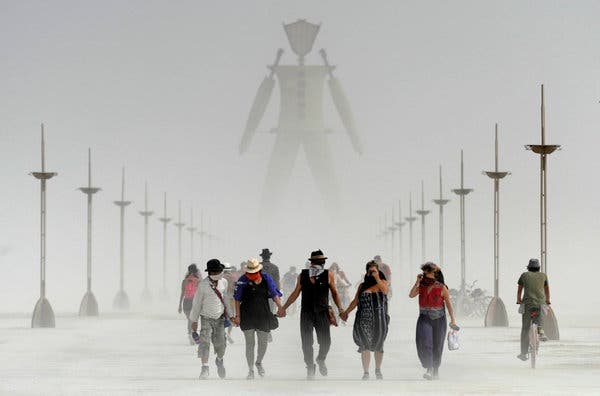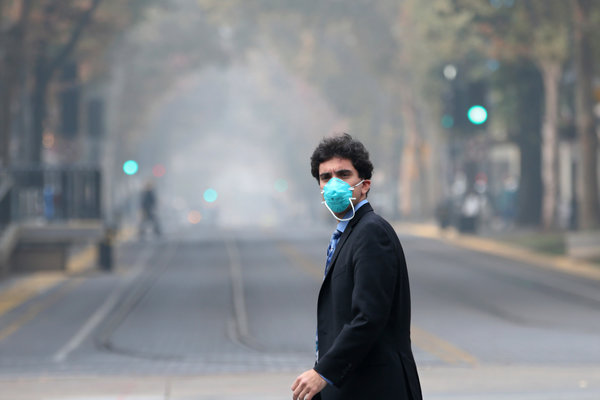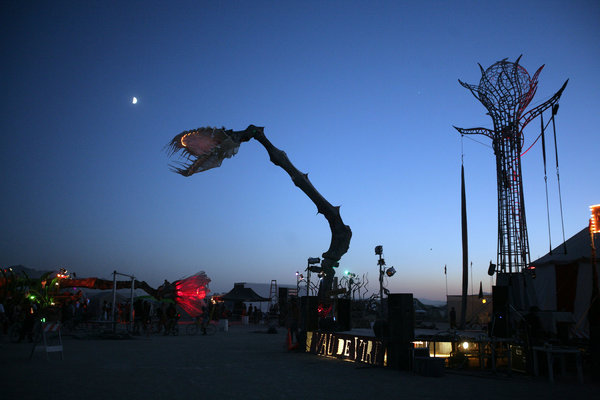When tens of thousands of people descend on Nevada’s Black Rock Desert in August for Burning Man, they should expect dust. A windstorm could sweep through the site at any moment, swirling the highly alkaline playa sand into clouds, and shrouding the festival’s temporary city and its attendants under its cloak. It’s best to come prepared.
Vogmask, a reusable face mask with an air filter, was designed with Burners in mind, but is intended to address environmental concerns broadly. When Marc Brown attended Burning Man in 2011, he was disappointed that there were “no cool-looking, highly efficient filtering face masks” to be found on the playa, despite the risk of what Burners have termed “playa lung,” an infection caused by the inhalation of alkaline silica dust from the desert.
So he and his mother, Wendover Brown, decided to make their own, working with medical design engineers to ensure its efficacy. Since founding Vogmask in 2012, they have seen demand rise, not just in the United States but around the world.
Vogmask is just one in a small but growing category of products designed to help people navigate an increasingly polluted planet.

CreditAndy Barron/The Reno Gazette-Journal, via Associated Press
Ali Aubuchon, a performance artist and speech language pathologist from New York City, experienced playa lung twice during her first three years at Burning Man. She now makes sure to have a mask on at all times in Black Rock City. “It’s a place that is not very easy to survive in without the proper supplies,” said Ms. Aubuchon, 38, who performs under the name Ali Luminescent.
Protective face masks are a common accessory in countries such as Japan, where they are meant to prevent the spread of illness, and China, where they are often used as protection against the country’s alarmingly high air pollution levels.
Mitsutoshi Horii, a sociology professor at Shumei University in Japan, has studied the use of face masks in Japanese culture. In a Skype call, he said that wearing the masks, a practice imported from the United States in 1919 after the Spanish influenza outbreak the year prior, evolved over the course of the 20th century into an accessory people use to deal with a variety of problems, such as airborne disease, air pollution and allergies.
Mr. Horii also sees the masks as a form of control over contemporary anxieties, like some religious rituals and superstitions. “When people feel uncertainty, masks are very easily accessible,” he said. “By wearing them people just feel safe, like they are doing something.”
Now, back in the United States, stylized surgical masks have appeared in celebrity paparazzi photos, pop stars’ tour wardrobes and fashion collections. Billie Eilish, Ariana Grande, Pharrell Williams and Pete Davidson have been spotted wearing them. Virgil Abloh’s Off-White label has its own line of face masks. And on Etsy, there are thousands of listings for handmade cloth surgical masks that are cute, but probably won’t keep you from getting sick.
Hannah and Anthony Martinez of Logan, Utah, decided to start their own line of masks after attending Lucidity, a festival in Santa Barbara, Calif. “Afterwards our allergies were so bad, and there was so much dust and gunk,” Ms. Martinez said.
The couple, who began selling rave and festival clothing on Etsy last year, made their first dust masks out of leftover fabric. Now their line includes a vibrant array of masks decorated with sequins, constellation drawings and abstract patterns.
For many people, however, the draw of these masks is purely practical. As wildfires, measles outbreaks and air quality alerts become more frequent, customers are turning to face mask manufacturers for protection against germs, allergens and other air particles. In California, air-filtering masks having become a common sight during wildfire season; in Utah, people frequently don them in the winter, when a phenomenon known as temperature inversion causes pollution to be trapped near the ground by a layer of warm air.
“Everybody on Earth at one point or another has said, ‘I shouldn’t be breathing this,’” Ms. Brown, of Vogmask, said.
As opposed to simple cloth masks, air-filtering masks such as Vogmask are designated by the F.D.A. as N95 respirators. The designation certifies the mask’s ability to block at least 95 percent of 0.3-micron air particles under strict lab testing conditions.
N95 respirators are much more effective than simple cloth masks in protecting those who wear them from particles in the air, said Richard Peltier, a professor of environmental health sciences at the University of Massachusetts, Amherst.
“Any time that you are filtering air through a pleated face mask, you are removing some particles. But it’s probably not really effective in reducing your exposure significantly,” he said. Even N95 masks only work against solid particles and larger liquid droplets containing pathogens; they do not prevent exposure to polluting gases such as carbon monoxide.
Other companies making these masks include O2Today, in Salt Lake City; Airinum, a Swedish company; MetaMask, in Auckland, New Zealand; and Cambridge Mask and Respro, both British ventures. Many of these companies are marketing their masks as both preventive care products and lifestyle accessories.
“A young person who needs to wear a mask to protect their own health, like for going to school or going out in public, is much more willing and happy to wear a beautiful mask than a medical looking mask,” Ms. Brown said.
That is especially the case for people with a compromised immune system, who often have to wear masks out of necessity. Emily Adams, 30, a spa manager from Beachwood, N.J., was diagnosed with cystic fibrosis at age 2. She welcomes the increasing popularity of air-filtering masks, which she wears to protect herself from infections.
“Now people can kind of look at me and be, like, ‘All right, maybe they are sick, but like that mask is actually pretty cool,’” she said.









